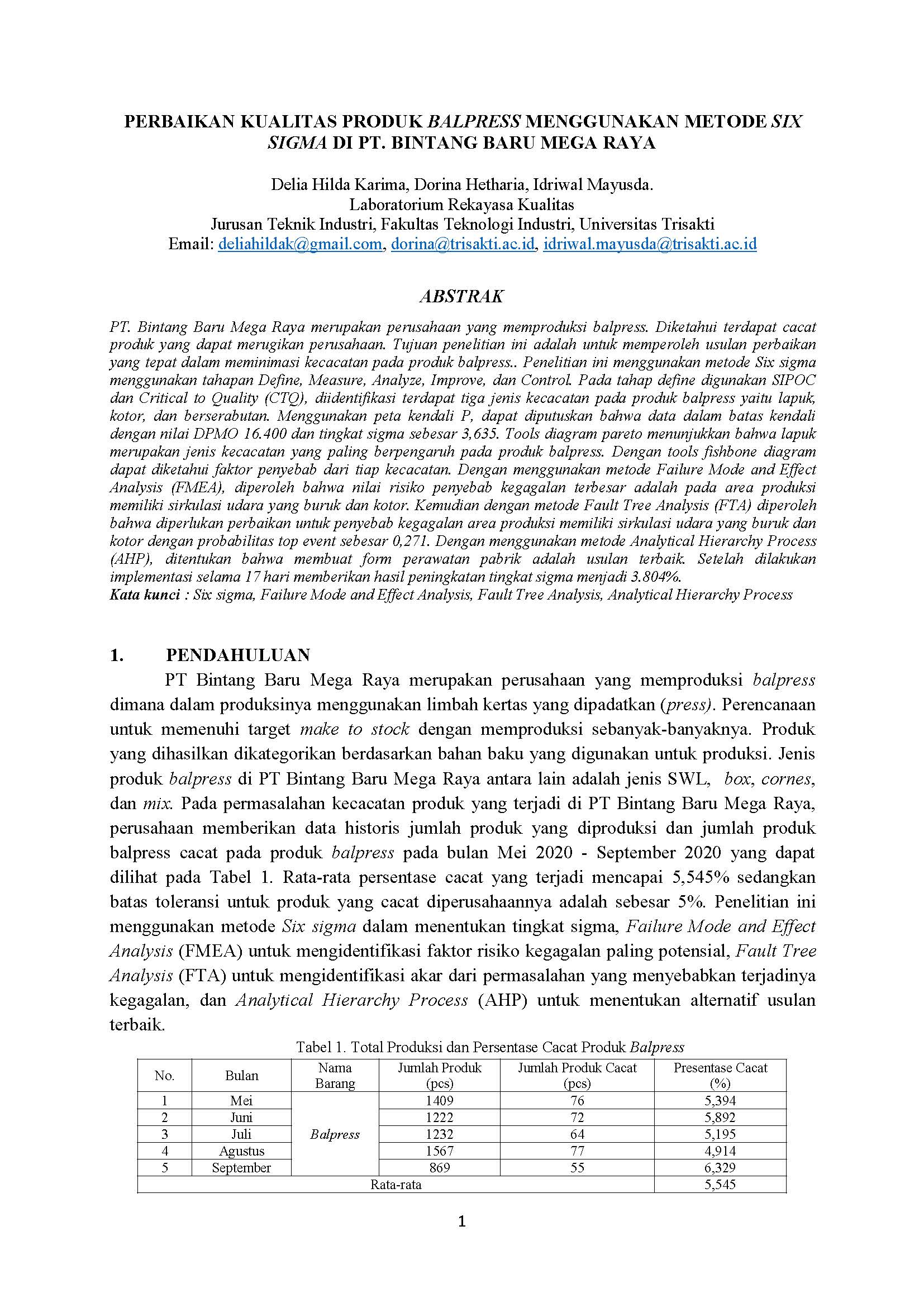Perbaikan kualitas produk balpress menggunakan metode six sigma di PT. Bintang Baru Mega Raya



Status Verifikasi : Sudah
Subyek : Commercial products - Quality control;Six sigma (Quality control standard)
Penerbit : FTI - Usakti
Kota Terbit : Jakarta
Tahun Terbit : 2021
Halaman : 19, p.
| No. | Nama File | Hal. | Link |
|---|---|---|---|
| 1. | 2021_MD_TI_-Perbaikan-kualitas-produk-balpress-_-Delia_-Dorina_-Idriwal.pdf |
|
P PT. Bintang Baru Mega Raya merupakan perusahaan yang memproduksi balpress. Diketahui terdapat cacat produk yang dapat merugikan perusahaan. Tujuan penelitian ini adalah untuk memperoleh usulan perbaikan yang tepat dalam meminimasi kecacatan pada produk balpress.. Penelitian ini menggunakan metode Six sigma menggunakan tahapan Define, Measure, Analyze, Improve, dan Control. Pada tahap define digunakan SIPOC dan Critical to Quality (CTQ), diidentifikasi terdapat tiga jenis kecacatan pada produk balpress yaitu lapuk, kotor, dan berserabutan. Menggunakan peta kendali P, dapat diputuskan bahwa data dalam batas kendali dengan nilai DPMO 16.400 dan tingkat sigma sebesar 3,635. Tools diagram pareto menunjukkan bahwa lapuk merupakan jenis kecacatan yang paling berpengaruh pada produk balpress. Dengan tools fishbone diagram dapat diketahui faktor penyebab dari tiap kecacatan. Dengan menggunakan metode Failure Mode and Effect Analysis (FMEA), diperoleh bahwa nilai risiko penyebab kegagalan terbesar adalah pada area produksi memiliki sirkulasi udara yang buruk dan kotor. Kemudian dengan metode Fault Tree Analysis (FTA) diperoleh bahwa diperlukan perbaikan untuk penyebab kegagalan area produksi memiliki sirkulasi udara yang buruk dan kotor dengan probabilitas top event sebesar 0,271. Dengan menggunakan metode Analytical Hierarchy Process (AHP), ditentukan bahwa membuat form perawatan pabrik adalah usulan terbaik. Setelah dilakukan implementasi selama 17 hari memberikan hasil peningkatan tingkat sigma menjadi 3.804%.
P PT. Bintang Baru Mega Raya is a company that produces balpress. It is known that there are product defects that can harm the company. The purpose of this research is to obtain the correct suggestions for improvement in minimizing defects in Balpress products. This study uses the Six Sigma method using the stages of Define, Measure, Analyze, Improve, and Control. In the define stage, SIPOC and Critical to Quality (CTQ) are used. There are three types of defects in Balpress products identified, namely weathered, dirty, and grubby. Using the P control chart, it can be concluded that the data is within the control limit with a DPMO value of 16,400 and a sigma level of 3,635. Pareto diagram tools show that weathering is the type of defect that has the most influence on Balpress products. With the fishbone diagram tools, the causes of each defect can be identified. By using the Failure Mode and Effect Analysis (FMEA) method, it is found that the value of the risk of the biggest cause of failure is that the production area has poor and dirty air circulation. Then with the Fault Tree Analysis (FTA) method, it is found that improvements are needed for the causes of failure of the production area to have bad and dirty air circulation with a top event probability of 0.271. By using the Analytical Hierarchy Process (AHP) method, it is determined that making factory maintenance forms is the best proposal. After 17 days of implementation, the result was an increase in the sigma level to 3,804%.